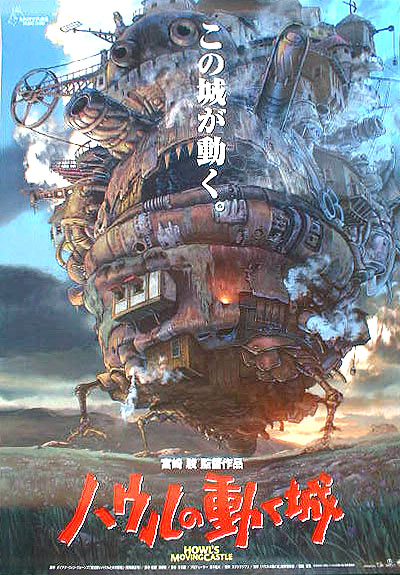The film is based on the book by Diana Wynne Jones and directed by the very able Hayao Miyazaki, famed anime director. Voices are provided by Christian Bale (Howl), Lauren Bacall, and Billy Crystal, among others, in the English version. The very talented Takuya Kimura provides Howl's or Hauru's voice in the Japanese version. Although not quite in the same league as some of the director's other work, it still is visually rich, tells a good tale, and satisfies the heart, if not the mind.
The movie explores the tenuous connection between fantasy and reality, and what happens when the two combine.
The Wicked Witch curses a young girl with old age, a similar curse to that employed in Snow White - with all its terrifying psychosexual connotations. She is afflicted even before the curse with an absolute lack of self-esteem, for reasons that are not made clear, but one surmises have to do with her flibbertigibbet of a mother. Sophie sets out to find her wizard, who is afflicted by a curse as well, one that compels him to remain a child emotionally, unwilling to own up to his responsibilities. The storyline is rich and complex, although various loose ends remain, and the Hollywood-style ending does not produce the necessary catharsis.
 The film is about responsibility - personal and social. At one point, Howl comments on seeing a flying battleship, and when asked whether it was the enemy's, that it does not matter in a futile war. He takes on his role as a protector of society only when he finds a connection with it, through Sophie. His need to keep moving, is counter-poised with his cumbersome castle, a monstrosity that would not be out of place in Gormenghast.
The film is about responsibility - personal and social. At one point, Howl comments on seeing a flying battleship, and when asked whether it was the enemy's, that it does not matter in a futile war. He takes on his role as a protector of society only when he finds a connection with it, through Sophie. His need to keep moving, is counter-poised with his cumbersome castle, a monstrosity that would not be out of place in Gormenghast.
The film is a simple children's tale at one level, with it's flashes and bangs, it's flying ships, talking fireplaces, and it's hopeful ending. At another level, it is a strong anti-war film, a film that tries to define a new mythology, aided by borrowings from sources as diverse as the Wizard of Oz, Grimm's tales, and Alice in Wonderland. It fails at this effort, and even at it's anti-war message, perhaps because of the convoluted plot-line, and an inability to clearly define the enemy - be it Madame Suliman, Calcifer or the Witch of the Waste. The book is somewhat different from the film, and hard to compare really - the film embodies the director's vision, making it his own perspective.
One of the nicest bits related to viewing this film was our visit to one of the local independent theaters, the Landmark Oriental theater- this film is currently only in limited release in the United States, courtesy of Disney, who have committed to exposing Miyazaki's films to a larger audience. The Oriental is a venerated place, circa 1927, for many fine films, including a regular live showing of The Rocky Horror Picture Show twice monthly at midnight. The screen is covered with curtain drops, and spooky, dimly lit Buddhas flank the seats. Audio is Dolby Digital, but there is little or no air-conditioning, the popcorn is cheap, and they give you a free CD with a combo. Every Friday and Saturday before the 7pm show in the main theatre, the lush sounds of the Kimball Theatre Pipe Organ introduce the film, just like the good old days. This pipe organ is the largest of its kind in a theatre in America, and the third largest in the world.
It could belong to a different time and world, much like this film.





No comments:
Post a Comment